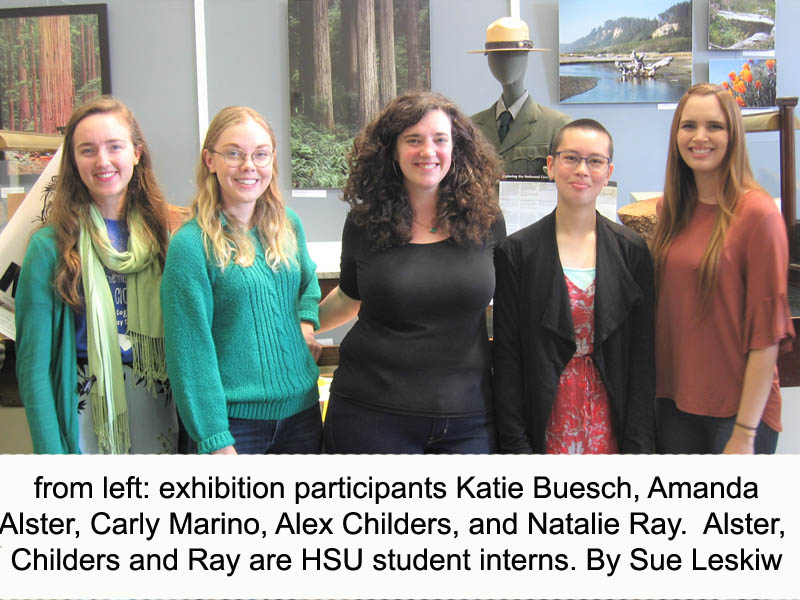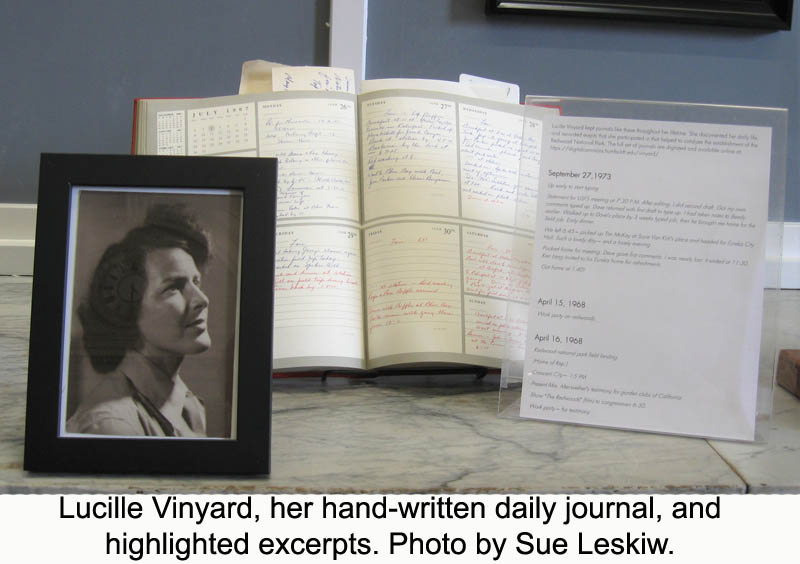By Sue Leskiw, North Group
Lucille Vinyard, North Group scion affectionately called “The Mother of Redwood National Park,” is one of the focal points in an exhibit on display at the Clarke Historical Museum in Eureka (www.clarkemuseum.org). Her journals, letters, and photos are part of “The Redwoods Provide[d]: Stories from the Establishment of Redwood National and State Parks,” which runs through January 5, 2019. The display is part of series of art and cultural events at locations throughout Humboldt County to celebrate the 50th anniversary of the park’s creation in 1968.
The exhibit– curated by Katie Buesch and cosponsored by Save the Redwoods League and Green Diamond Resource Company– explores how loggers and conservationists were both united and divided by redwoods. Its goal is to “investigate the different views and reasoning in people’s support or opposition to the establishment of Redwood National Park and its later expansion.” The arrangement flows to tell a story. The right-hand side of the show explores the history of how those iconic trees were cut down and used, the center section takes the visitor through the conflict and resolution over preserving some in a national park, and the left-hand part introduces the major environmental players in the process.
The first section the visitor sees includes cases full of early logging tools, iconic photos such as nine loggers sitting in an undercut giant, and products made from redwood burls (among them bowls, boxes, a chess set, postcards, and even a phonograph record that plays “Beautiful Dreamer” on one side and a spoken history of the redwoods on the other). In Humboldt County in the late 1960s, 70 percent of local industry was tied to lumber.
The middle part deals with turning points in the debate over creating the park, mainly through media clippings such as a March 1966 newspaper article that quotes Don Cave, a Eureka stockbroker and chair of the Redwoods Committee, a timber industry-financed group that opposed federal Redwood National Park plans for Humboldt and Del Norte counties: “Every time I mention a redwood tree, the extremists go into a spiritual fit.” A Senate hearing held in Del Norte County in June 1966 attracted 117 witnesses. Mannequins face off representing an eco-protester holding a sign reading “Better Redwood Than Dead Wood” and a logger with an “angry logger” poster that was part of the “Talk to America” convoy of 26 trucks that drove to Washington, DC in 1978 to protest the park expansion.
The last portion focuses on the Save the Redwoods League, the Sierra Club in general, and the late Lucille Vinyard in particular. Her glass case includes one of her many hand-written daily journals, which are being digitized by Humboldt State University student interns under the direction of special collections librarian Carly Marino. Eighteen students have been funded by project underwriter Redwood National and State Parks, with the results posted at www.rnp.omeka.net. “Journal entries have ranged from the mundane ‘I played golf today’ to the consequential ‘Today I attended a Senate subcommittee hearing on establishing a national park,’" states Marino. The students are attempting to match up photographs with the journal entries. Lucille’s case also includes her original typed open letter to President Johnson “on the last chance to really save the redwoods” that was published in newspapers such as the New York Times, Washington Post, Los Angeles Times, San Francisco Chronicle, and Sacramento Bee, plus her scrapbook of clippings between November 1964 and January 1966 “with subject matter pertinent to establishment of a Redwood National Park, lumber industry, state parks, conservation, natural beauty, tourism, and county politics.”
Attendees at the July 7 exhibit opening and the Eureka Street Art Fair in August were given a sheet of colored paper and a marker to write their personal redwoods story. The comments were then pasted to the wall in the alley that runs along the Clarke Museum. While many are one sentence long, others are a drawing, poem, or story. “Some people were nearly crying because of how the redwoods speak to them,” notes Buesch.
Redwood National Park was the most expensive U.S. national park to establish, since most of the land and timber had to be purchased from private owners at what courts determined to be fair market value. The exhibit includes a deposit receipt for $111 million from the U.S. Government to Simpson Timber Company, which was the smallest of the three owner companies. $59 million represented the value of the land and $52 million was interest that accrued in the eight to nine years it took to determine the land’s value! Money was also set aside to rehabilitate logged-over land and to help those who lost their jobs due to reduced logging. The 1978 park expansion cost an additional $350 million.
Readers can share their redwoods experience with the Museum by using the hashtag #theredwoodsprovided.

